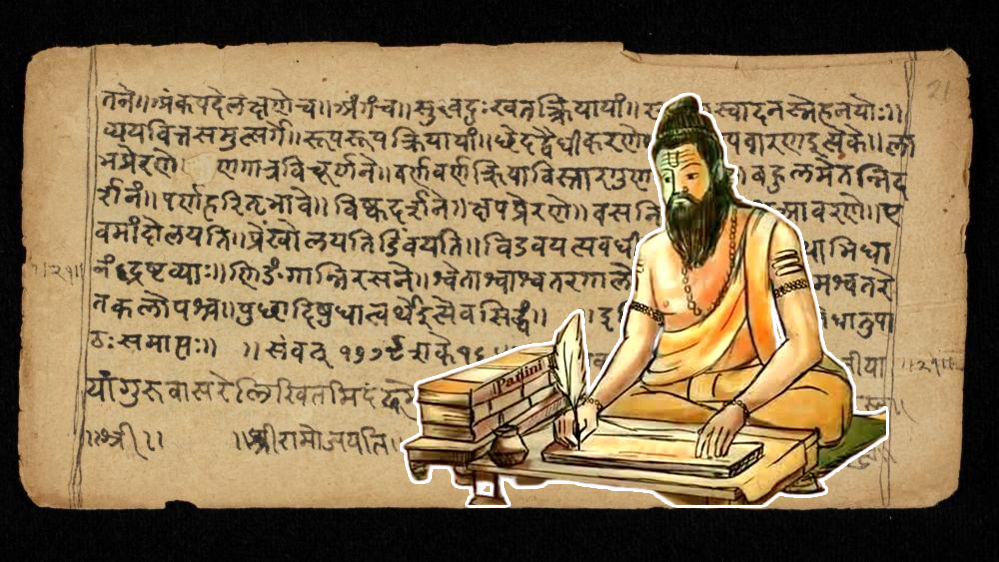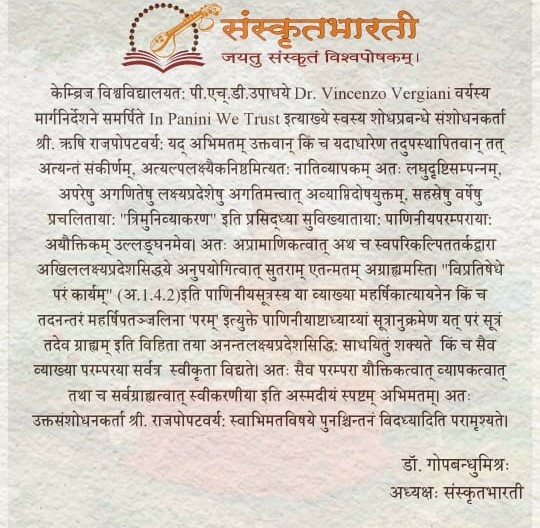|
Getting your Trinity Audio player ready...
|

A week ago, the media all over the world was taken by a storm of news that a PhD scholar Rishi Rajpopat from Cambridge University has solved a 2500-year-old problem with Paninian grammar that had defeated the Sanskrit scholars all along according to the media reports. The news had become viral over the TV, and internet media with people forwarding the proud news that an Indian scholar has finally solved the problem. What was not clear was how this news first covered by the BBC and later covered by the British media did not take an independent review regarding the veracity behind the claim.
Let us try to understand more about the claim. The work done by Dr Rishi Rajpopat at Cambridge regarding the great Sanskrit grammarian work by Panini who lived 2500 years ago. The title of the thesis is “In Panini We Trust ” with the subtitle, ‘Discovering the algorithm for rule conflict resolution in the Ashtadhyayi’.
The celebrated work Ashtadhyayi contains nearly 4000 rules that determine how each word is derived from the root word. The rules determine under which rules particular alphabets are added in sequence to the root word to arrive at the final word. Panini framed these rules, which has made Sanskrit the most scientific language even from the machine learning point of view.
During the process of these derivation steps, two rules can simultaneously be applied. Panini had given a resolution for this problem also by stating that in such a situation when two rules become applicable simultaneously, the rule that comes later in Ashtadhyayi shall preside.
Dr Rishi Rajpopat who had a passion for Paninian grammar took this topic as a PhD thesis topic and came out with an algorithm that he claimed corrected the wrong interpretation of Paninian grammar rules that got misinterpreted right from the times of Katyayana who wrote the first commentary and many others till date. The claim was quite dashing, bold and quite a pompous one that got spread around the world.
What was surprising is that the work has not been published in any journal for peer review, but a claim has been made that this work has solved the 2500-year-old problem. Several academicians around the world since then have come out with critical analysis papers which seem to have pointed out the rather premature and fake claim propagated.
Prof Peter M Scharf an internationally acclaimed Sanskrit scholar who has been developing a computational implementation of Paninian grammar has made a critical observation that Dr Rajpopat has not sufficiently examined or understood the discussions in the commentaries regarding the traditional interpretation of the meta-rule A1.4.2 Vipratisedhe Param Karyam, the meta-rule he proposed in his new algorithm. Prof Scharf has opined that the solutions offered by Dr Rajpopat are largely ineffective. He has stated the self-proclaimed “ingenious algorithm” needs further examination.
Another scholar, Neelesh Bodas who has been teaching Paninian grammar for quite some time has come out with a critical analysis through his paper and video presentation, by far the best evidence-based critic on this thesis. Mr Bodas makes it clear that “he does not support, believe or encourage the statements that a 2500-year-old puzzle is solved” or “Katyayana chose wrong interpretation” and so on.
Mr Bodas brings out the faulty understanding of Dr Rajpopat in the traditional understanding of the Paninian grammar rules and erroneously interpreting them.
The DOI (Different Operand Interaction) proposed by Dr Rajpopat has been cited by both Prof Scharf and Bodas as not working in various patterns. However, Mr Bodas suggested the DOI algorithm proposed needs exhaustive testing with 1,00,000 to 5,00,000 more examples before it can be termed sound and working.
Dr John Lowe, an associate professor in Sanskrit studies from Oxford University in a discussion inside an Indology forum has expressed his displeasure of having made an unsubstantiated claim in front of the BBC and other British media that has since been broadcasted far and wide.
An Indian scholar of repute Sri Nityananda Misra who has been educating the masses ever since this claim was made and makes a balanced observation that unless the work has been extensively peer-reviewed, such claims of solving 2500-year-old puzzle which is either coming off from the author or Cambridge university ought not to have happened. Nevertheless, Dr Rajpopat needs to be commended for his passion in taking the work on Paninian grammar and producing a thesis.
Samskrutabharathi from India has issued a communication describing the work being “Very narrow, short-visioned work bereft of wider scope”.

Further, the view of experts is that Katyanana and Patanjali have interpreted the metarule 1.4.2 in a certain way, which is definitely authentic with universal applicability, and they will continue to believe in that because the new interpretation of 1.4.2 by Dr Rajpopat is full of flaws.

The Central Sanskrit University in India has decided to set up a Vidhwat Parishad of scholars in this domain to examine the thesis work from an academic perspective.
An area such as Sanskrit that too the area of Paninian grammar has managed to stir academic circles showing the growing popularity of Sanskrit among the general public. However, one would wish, Dr Rajpopat should have been careful in media interactions while talking about tradition in his thesis and in the media as these systems have survived strongly for 2500 years in a rich tradition.
(The article was first published on BharatVoice. Republished with permission. Views expressed are the author’s own)

Very good article. Contents are neatly presented